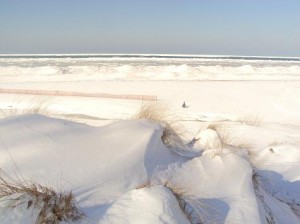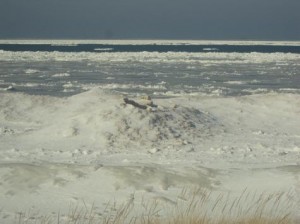Adult children joke about the parental cautions of their childhoods:
- Stop crying, or I’ll give you something to cry about!
- You’re going to poke your eye out with that thing!
- Don’t run with the scissors in your hand!
- Stop that before somebody gets hurt!
- You don’t know how good you have it!
Our parents didn’t use those exact words, but their ideas were the same. Dad cautioned us far more than Mom, lecturing us frequently on all things dangerous. One life and death issue he harped on during our childhood was not climbing the mounds of ice along Lake Michigan’s winter shoreline.
“Even when its frozen, there’s moving water underneath, making all of it unstable.” He was correct, of course, but we all knew if the right circumstances came along, we’d be on those ice mounds in a flash.
This weekend the right circumstances came along. Mary and I took our dogs to the beach where they love to run up and down the snow-covered dunes side by side like a team of miniature horses. Climbing up over the dune ourselves, we gasped at our first glimpse of the lake.
There were three rows of ice-mountains running the length of the shoreline, stretching for miles in both directions. These consecutive hills rose eight to ten feet with icy valleys in between, a frozen roller coaster toward frigid water, each peak less reliable than the one before.
Mary and I agreed the whole scene was calling us to its beauty. With difficulty because of glare ice hidden beneath the snow, we scaled the first ridge, crawling on hands and knees to avoid falling.
Vowing to go no further as we repeated Dad’s ancient lecture to each other, the draw of the second ridge drowned out his cautions and coaxed us to come. We had to sit on the ice to scoot down into the valley and then climbed up the middle ridge, teetering on its narrow peak while we took in a 360 degree postcard-perfect view. Looking back at the distant dunes, however, we calculated we were well “out to sea” over the swirling water Dad had assured us was beneath the ice.
“Only the dogs will witness our drownings,” Mary said.
“They’ll probably drown along with us,” I added.
From what we could see, the frozen water beyond the third ridge was clear and blue, a wonder we yearned to get close to. We slid into the second valley and as the wind whipped sideways at our parkas, talked at length about inching up the last mound for one quick look over the top. But the weather had been above freezing that day, and Dad hadn’t told us whether top-ice or under-ice would melt first. In the end, his warnings terminated our battle with temptation. We didn’t climb the third peak but turned back toward solid ground, two old ladies having had two-thirds of an adventure.
It’s good to know when to stop. All of us have gotten into trouble pushing the limits on risky behavior, which forced us to pay the piper when it was over. Taking chances for a valid reason is one thing, but taking chances just for fun is not good.
Some people risk the one thing that matters most, life after death. They’re sure death ends everything, then find out it isn’t true. By then it’s too late to do anything about it.
A second risky possibility is to postpone thoughts of spiritual matters with a self-promise to think about it in old age, but then to die young. Both scenarios are tantamount to walking on thin ice.
As Mary and I turned toward the dune, we watched Jack and Sydney race ahead in tandem. Sydney ran across the frozen creek but suddenly dropped through the ice up to her chest, quickly climbing out with a surprised look on her face. Jack’s path across had stayed solid. We were still laughing when I got my own chilly surprise. Despite following Jack’s solid paw prints, I went through the ice up to my knee anyway. Brrr! It would have been better to follow someone heavier than I was.
“I am God, and there is no other; I am God, and there is none like me. I make known the end from the beginning, from ancient times, what is still to come. I say: My purpose will stand, and I will do all that I please.” (Isaiah 46:9-10)




